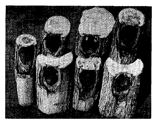
Journal of Arboriculture 9(12): December 1983
327

Figure 19. All wounds on this red oak were still open after 7 years, and large pockets of decayed wood were associated with all wounds. Left to right: shellac, rosin acid I, Treekote, and control.

Figure 20. All wounds on this red oak were still open after 7
years, and similar-sized pockets of decayed wood were associated with the
wounds. Left to right: control, shellac, rosin acid I, and Treekote

Figure 21. Seven wounds, each 7 years old, from seven red
maple trees. All wounds treated with Treekote. Note the great
variation in dieback, callus formation, and amount of decayed wood. Note
extensive decay in two wounds (A and B).

Figure 22. Seven wounds, each 7 years old, from seven red maple
trees. All wounds treated with rosin acid I. Note variation in
dieback, callus formation, and decayed wood. Note extensive decay
decay in two wounds (A and B).

Figure 23. Seven wounds, each 7 years old, from seven red maple trees. All wounds treated with shellac. Note decayed wood In three wounds (A, B, and C).

Figure 24. Seven wounds, each 7 years old, from seven red maple trees. All wounds were not treated — controls. Note decayed wood In three wounds (A, B, and C).

Figure 25. Two 7-year-old Treekote-treated wounds from red maple trees. The upper sample had extensive decayed wood, while the lower sample had no decayed wood. The lower sample had a wide band of healthy wood behind the wound. The upper sample had a narrow band of healthy wood separating the experimentally inflicted wound from the large central column of discolored wood already present. The width of healthy wood behind wounds is an important factor affecting the development and spread of decayed wood.

Figure 26. Two samples showing the same patterns as in figure 25, except that the wounds were not treated.

Figure 27. Summary of basic patterns in red maple that affect the development and spread of decay after wounding. Tree A has a wide band of healthy wood. Wounds inflicted at positions 1 and 2 will rarely develop decay, regardless of whether the wounds are treated or not. Tree B has a large column of central defect and a thin band of healthy wood. Wounds inflicted at positions 1 and 2 will usually develop decay rapidly, regardless of whether they are treated or not. Tree C has a wide band of healthy wood on one side, and a thin band of healthy wood on the other side. A wound inflicted at position 1 will usually develop decay rapidly, whether treated or not. A wound inflicted in position 2 will seldom develop decay, whether treated or not. Tree D has the pith far on one side, and a small column of central defect. A wound at position 1 will seldom develop decay, whether treated or not. A wound at position 2 will usually develop decay, regardless of treatment.